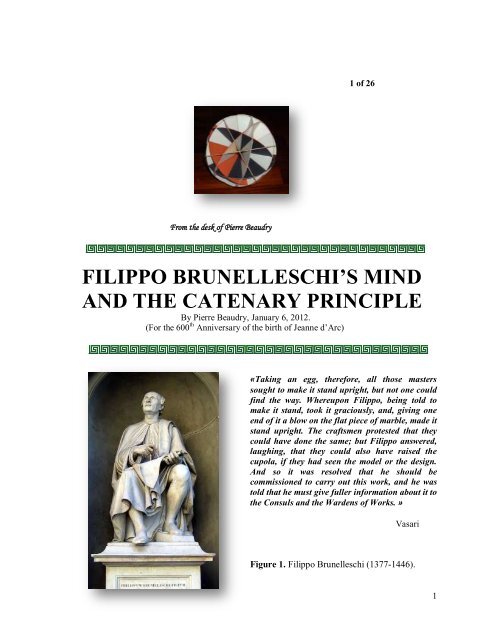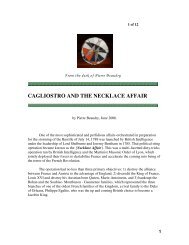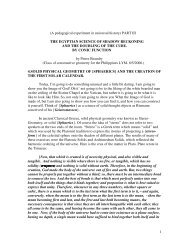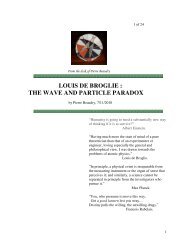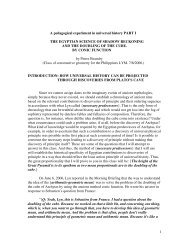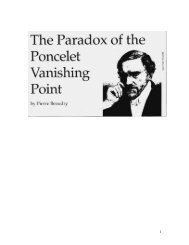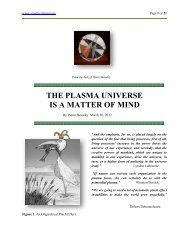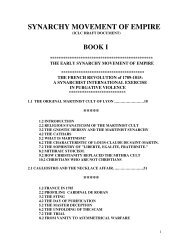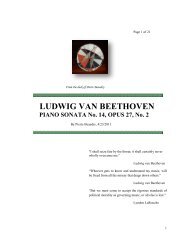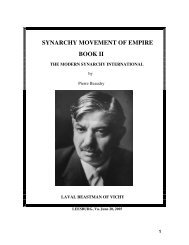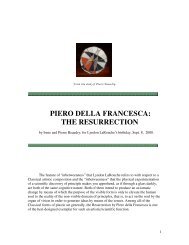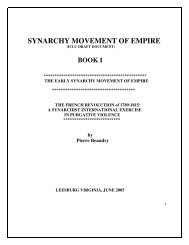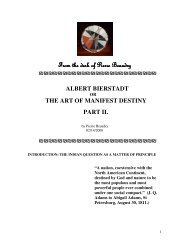filippo brunelleschi's mind and the catenary principle - Pierre ...
filippo brunelleschi's mind and the catenary principle - Pierre ...
filippo brunelleschi's mind and the catenary principle - Pierre ...
Create successful ePaper yourself
Turn your PDF publications into a flip-book with our unique Google optimized e-Paper software.
1 of 26From <strong>the</strong> desk of <strong>Pierre</strong> BeaudryFILIPPO BRUNELLESCHI’S MINDAND THE CATENARY PRINCIPLEBy <strong>Pierre</strong> Beaudry, January 6, 2012.(For <strong>the</strong> 600 th Anniversary of <strong>the</strong> birth of Jeanne d’Arc)«Taking an egg, <strong>the</strong>refore, all those masterssought to make it st<strong>and</strong> upright, but not one couldfind <strong>the</strong> way. Whereupon Filippo, being told tomake it st<strong>and</strong>, took it graciously, <strong>and</strong>, giving oneend of it a blow on <strong>the</strong> flat piece of marble, made itst<strong>and</strong> upright. The craftsmen protested that <strong>the</strong>ycould have done <strong>the</strong> same; but Filippo answered,laughing, that <strong>the</strong>y could also have raised <strong>the</strong>cupola, if <strong>the</strong>y had seen <strong>the</strong> model or <strong>the</strong> design.And so it was resolved that he should becommissioned to carry out this work, <strong>and</strong> he wastold that he must give fuller information about it to<strong>the</strong> Consuls <strong>and</strong> <strong>the</strong> Wardens of Works. »VasariFigure 1. Filippo Brunelleschi (1377-1446).1
The two greatest domes of former times, <strong>the</strong> Pan<strong>the</strong>on in Rome <strong>and</strong> Hagia Sophia in Istanbul, didnot require <strong>the</strong> discovery of any new physical <strong>principle</strong> for <strong>the</strong>ir erection, because those two churches hadbrought to <strong>the</strong> limit of feasibility <strong>the</strong> erection of great spherical domes, by means of <strong>the</strong> method ofconstruction from <strong>the</strong> bottom up; that is, with <strong>the</strong> use of central wooden platforms <strong>and</strong> multiplescaffoldings that took care of <strong>the</strong> two problems that every dome builder encounters, compression <strong>and</strong>tension, or more commonly known as push <strong>and</strong> pull, in order to prevent excessive outward horizontalthrust that architects call “hoop stress.” which causes domes to stretch at <strong>the</strong> circumference of <strong>the</strong>ir base.Note <strong>the</strong> (1) first stone chain at <strong>the</strong> base of <strong>the</strong> Brunelleschi cupola (Figure 3.)Figure 3 “STRUCTURAL DESIGN AND CONSTRUCTION OF BRUNELLESCHI’S DUOMO DISANTA MARIA DEL FIORE,” by T. Russell Gentry <strong>and</strong> Anatoliusz “Tolek” Lesniewski.4
However, for Brunelleschi, what was essential was <strong>the</strong> discovery of a method of erecting <strong>the</strong>great cupola of Florence from <strong>the</strong> heavens; that is, from <strong>the</strong> top down. The task required a state of <strong>mind</strong>that was completely different from everyone else’s. The task was fundamentally galactic in character. Thequestion was: how do you replicate <strong>the</strong> <strong>principle</strong> underlying <strong>the</strong> dome of <strong>the</strong> heavens <strong>and</strong> apply it to <strong>the</strong>140 year old octagonal drum of <strong>the</strong> church of Santa Maria del Fiore?Part of <strong>the</strong> answer to this question is found in Cusa’s isoperimetric <strong>principle</strong> of least action. But,<strong>the</strong> <strong>principle</strong> of Cusa was not sufficient. Brunelleschi had to devise, first in his own <strong>mind</strong>, <strong>the</strong> completedform of a self-erecting cupola that would be completely self-sustaining in each of its parts as well as in itstotality. His problem was to discover what sort of new universal physical <strong>principle</strong> could resonate inaccordance with <strong>the</strong> isoperimetric <strong>principle</strong> of Cusa <strong>and</strong> be applied to a new form of paradoxical cupolathat never existed before, that is, a Gothic Dome. The fundamental requirement was to establish adynamic vault structure which would be self-reliant <strong>and</strong> would be erected without any external support.This intention required <strong>the</strong> discovery of a new physical <strong>principle</strong> of least action above <strong>and</strong> beyond whatCusa had already discovered, <strong>and</strong> above <strong>and</strong> beyond already existing architectonic <strong>principle</strong>s. Theproblem required going beyond <strong>the</strong> limits of simple circular <strong>and</strong> spherical action, <strong>and</strong> Brunelleschi wasst<strong>and</strong>ing alone in front of <strong>the</strong> future asking: “How do you go beyond <strong>the</strong> limits of an axiomatic change?”Specifically, what Brunelleschi had to do was to discover how to go beyond <strong>the</strong> limits of positivecurvature exemplified by Romanesque domes <strong>and</strong> arches of <strong>the</strong> past. He had to break completely withtradition <strong>and</strong> with every architectural idea that existed up to that time. He had to discover how <strong>the</strong><strong>principle</strong> of positive curvature <strong>and</strong> <strong>the</strong> <strong>principle</strong> of negative curvature came toge<strong>the</strong>r harmonically. Thatwas <strong>the</strong> only way to solve <strong>the</strong> limitations posed by <strong>the</strong> Florentine cupola.By investigating <strong>the</strong> new domain of negative curvature with Cusa, Brunelleschi was alreadypreparing <strong>the</strong> terrain for Leonardo da Vinci, Leibniz, Gauss, <strong>and</strong> Riemann’s transcendental functions ofelliptic <strong>and</strong> hyperbolic constructive geometry, <strong>and</strong> he was exp<strong>and</strong>ing human knowledge in <strong>the</strong> direction ofa new form of galactic thinking that required <strong>the</strong> investigation of singularities of magnetohydrodynamicnature, such as shock waves in <strong>the</strong> domain of universal cosmic radiation. It is by studying <strong>the</strong> limitconditions of such an axiomatic system like <strong>the</strong> system of positive <strong>and</strong> negative curvatures of a cupola,<strong>and</strong> by introducing new hypo<strong>the</strong>ses for experimenting with <strong>the</strong> tensile capacity of change in curvatureunder great pressure that new discoveries of <strong>principle</strong> are made. Those are <strong>the</strong> non-linear conditions thatBrunelleschi required to apply to his cupola that Cusa helped to bring about.What Cusa introduced in his 1440 publication of Docta Ignorantia was <strong>the</strong> sort of meditation thatSaint Augustine had already identified as <strong>the</strong> extra measure of help that God brings to man when herecognizes his weaknesses at <strong>the</strong> limits of his creative thinking process. As Augustine put it: “Therefore,as I say, <strong>the</strong>re is in us a certain learned ignorance, but learned from <strong>the</strong> Spirit of God, who helps us inour weakness.” «Est ergo in nobis quaedam, ut dicam, docta ignorantia, sed docta spiritu dei, quiadiuvat infirmitatem nostram » (Epist. ad Probam 130, c. 15, § 28) That is to say, at <strong>the</strong> limit, <strong>the</strong>re is aknowledge of <strong>principle</strong>s that is beyond sense-perception <strong>and</strong> beyond human underst<strong>and</strong>ing, but which islocated in <strong>the</strong> axiomatic changes that Brunelleschi <strong>and</strong> Cusa identified as <strong>the</strong> boundary conditionsbetween scientific knowledge, artistic composition, <strong>and</strong> <strong>the</strong> infinite. Cusa provided Brunelleschi with <strong>the</strong>knowledge that would lead him to discover <strong>the</strong> solution to <strong>the</strong> identification of opposites in his own5
domain of architecture, which made him solve <strong>the</strong> minimum-maximum paradox of <strong>the</strong> greatest artisticcomposition ever built. Brunelleschi’s paradox consisted in discovering how to generate, inside of <strong>the</strong>cupola, a unity of effect that would bring toge<strong>the</strong>r those two simultaneous <strong>and</strong> opposite forms of positive<strong>and</strong> negative curvature. The key to unlock that mystery was to mix toge<strong>the</strong>r <strong>the</strong> <strong>principle</strong>s of positive <strong>and</strong>of negative curvature proportionately <strong>and</strong> harmonically.1. THE CUPOLA’S DOUBLE POSITIVE AND NEGATIVE CURVATURE.“Strain is never caused by stress. Strain iscaused by a defective curvature in physicalspace-time.”Dehors Debonneheure.If you wish to underst<strong>and</strong> how <strong>the</strong> mental process works toge<strong>the</strong>r with <strong>the</strong> galactic process, youhave to examine how Brunelleschi connected <strong>the</strong> <strong>catenary</strong> <strong>principle</strong> <strong>and</strong> <strong>the</strong> isoperimetric <strong>principle</strong> togenerate <strong>the</strong> doubly-connected positive <strong>and</strong> negative curvature of <strong>the</strong> cupola of <strong>the</strong> Florence Ca<strong>the</strong>dral.Curiously, <strong>the</strong> same two <strong>principle</strong>s are necessary to underst<strong>and</strong> <strong>the</strong> mental behavior of <strong>the</strong> galaxy as aphysical space-time doubly-connected manifold. See my report on Fusion Power is not Democratic.Let’s summarize <strong>the</strong> process, again. First of all, Brunelleschi started to build his cupola from <strong>the</strong>top down. He connected <strong>the</strong> Cusa isoperimetric <strong>principle</strong> with <strong>the</strong> <strong>catenary</strong> <strong>principle</strong> in order to first solve<strong>the</strong> problem of <strong>the</strong> Lantern. Indeed, how could such a heavy lantern be erected onto <strong>the</strong> cupola withoutcrushing everything under its weight? Then, he introduced <strong>the</strong> idea of four sets of stone <strong>and</strong> iron chainsthat encircled <strong>the</strong> eight ribs of <strong>the</strong> cupola, like major third divisions of a musical octave, with suchintervals as C, E, Ad, C; two at <strong>the</strong> top <strong>and</strong> at <strong>the</strong> bottom, <strong>and</strong> two equally spaced in between, thusdividing a paradoxical gothic conical dome into three separate areas of stress in accordance with <strong>the</strong>conical spiral divisions held toge<strong>the</strong>r by chains. These consonant chains act as shock absorbers at equalintervals of <strong>the</strong> cupola, like singularities through which <strong>the</strong> stresses of <strong>the</strong> cupola as a whole resonate byallowing for change in time, <strong>and</strong> also by absorbing <strong>the</strong> regular shocks of lightning strikes against <strong>the</strong>lantern. As a result, <strong>the</strong> cupola became capable of taking a maximum amount of stress with a minimumamount of external support. This is <strong>the</strong> central organizing <strong>principle</strong> of <strong>the</strong> cupola.The four sets of chains encircling <strong>the</strong> circumference of <strong>the</strong> inner <strong>and</strong> outer domes also have <strong>the</strong>function of transferring <strong>the</strong> pressure of <strong>the</strong> cupola onto <strong>the</strong> eight ribs of <strong>the</strong> cage which carry <strong>the</strong> entireweight of <strong>the</strong> dome, including <strong>the</strong> lantern. This function is very similar to that of stays which carry <strong>the</strong>weight of a hanging roadway such as <strong>the</strong> Brooklyn Bridge (Figure 6), or which calls for flying buttressesto take <strong>the</strong> outward thrust from <strong>the</strong> main body of a gothic ca<strong>the</strong>dral. The double curvature of <strong>the</strong> cupolaconcentrated <strong>the</strong> power within its closed configuration like <strong>the</strong> gestalt formation of a new <strong>principle</strong>containing all of its elements within itself. In this way, <strong>the</strong> curvature was capable of channeling <strong>the</strong> lateralthrusts of <strong>the</strong> cupola all <strong>the</strong> way to <strong>the</strong> ground without danger, as if by defying gravity.6
The critical containment <strong>and</strong> <strong>the</strong> key resonating feature, however, was <strong>the</strong> negatively curvedherringbone or spinapesce brick pattern of negative curvature. The sixteen great spiraling herringbonemembranes of both shells acted as cohesive self-supporting arches between every two of <strong>the</strong> great ribs of<strong>the</strong> cupola to secure <strong>the</strong> bricks in place while <strong>the</strong> mortar was setting. The whole process had to be done intime, because <strong>the</strong> whole purpose of <strong>the</strong> herringbone design was to transfer <strong>the</strong> weight of 4 million brickshorizontally onto <strong>the</strong> eight vertical ribs before <strong>the</strong>y slipped to <strong>the</strong> ground. This was a doubly-invertedfunction which generated negative curvature as a physical space-time function. In that sense, <strong>the</strong> cupolawas <strong>the</strong> first scientific application of a self-sustaining zero-gravity system formed by a doubly-connectedmanifold of negative <strong>and</strong> positive curvature, that was generated by <strong>the</strong> contradictory functions of <strong>the</strong>isoperimetric <strong>principle</strong> <strong>and</strong> <strong>the</strong> <strong>catenary</strong> <strong>principle</strong>. The bricks were all arranged to reduce <strong>the</strong> effect ofgravity by means of combining <strong>the</strong> power of those two <strong>principle</strong>s. This is <strong>the</strong> inverse of what happens ona trip to Mars where gravity needs to be increased by acceleration or deceleration. Here, gravity must bedecreased to zero. As a matter of fact, this is always how an axiomatic change works.Figure 4. The combination of <strong>the</strong> <strong>catenary</strong> “corda bl<strong>and</strong>a” (slack line) measure for <strong>the</strong> herringbonebricklaying with <strong>the</strong> radii of <strong>the</strong> isoperimetric pointed fifth <strong>and</strong> pointed fourth (C”) integrate <strong>the</strong> positive<strong>and</strong> negative curvatures of <strong>the</strong> whole cupola. (Image by Ippolito <strong>and</strong> Peroni, La Cupola di Santa Mariadel Fiore, 1997)7
A similar self-sustaining process of physical space-time curvature exists in which a galaxy or anebula evolves through retarded or accelerated contraction of its plasma jets though <strong>the</strong> compression ofboth positive <strong>and</strong> negative curvatures of <strong>the</strong>ir magnetic fields. The chains of <strong>the</strong> Brunelleschi cupola actlike compressed magnetic fields against <strong>the</strong> outward gravitational thrust of <strong>the</strong> cupola, while <strong>the</strong> verticalgravitational tendency of <strong>the</strong> 4 million bricks’ motion, which is perpendicular to <strong>the</strong> constantly changingradii of curvature of <strong>the</strong> membranes, is pulled back horizontally toward <strong>the</strong> ribs by <strong>the</strong> inverse curvaturefunction of <strong>the</strong> <strong>catenary</strong>. This is how force-free plasma vortex filaments of large numbers of electronsorganize each o<strong>the</strong>r into definite patterns of self-sustaining curvature inside of <strong>the</strong> galactic magnetic field.Similar accelerated electromagnetic ram actions, as occurring in active galaxies, have also been observedin laboratories such as <strong>the</strong> Livermore National Laboratory. (See Winston Bostick, A way Out of <strong>the</strong>Quasar Redshift Shambles, July-August 1989 issue of 21 st Century)This ultimately demonstrates that strain is not generated by stress, as modern <strong>the</strong>ory on elasticityclaims it to be. It is not by eliminating internal stress in a linear manner that <strong>the</strong> Brunelleschi cupola wasable to resist <strong>the</strong> powerful compression of gravity, but, in fact, by increasing <strong>the</strong> internal energy fluxdensityof <strong>the</strong> cupola with an axiomatic change in curvature. As for <strong>the</strong> cracks in <strong>the</strong> cupola that havebeen observed in <strong>the</strong> 1980’s, <strong>the</strong>y are due mostly to seismic activity, <strong>and</strong> not to any faulty conception ofcurvature. “The increase in <strong>the</strong> width of <strong>the</strong> cracks took place in a period characterized by considerableseismic activity as well as by variations in climate <strong>and</strong> by a lowering of <strong>the</strong> water-bearing stratum.”(Gianni Bartoli, Andrea Chiarugi, <strong>and</strong> Vittorio Gusella, Monitoring Systems on Historic Buildings: TheBrunelleschi Dome, Journal of Structural Engineering, June 1996, p. 672.)Now, after consideration of <strong>the</strong>se few elementary components, ask yourself: how can <strong>the</strong> <strong>catenary</strong><strong>principle</strong> represent <strong>the</strong> interconnectedness between <strong>the</strong> universal galactic process <strong>and</strong> <strong>the</strong> mental processof <strong>the</strong> creative human <strong>mind</strong>? First <strong>and</strong> foremost,don’t look for <strong>the</strong> presence of <strong>the</strong> <strong>catenary</strong> chain in<strong>the</strong> structure of <strong>the</strong> cupola, as such. The <strong>catenary</strong><strong>principle</strong> is not a sense-perception thing. Examine,instead, <strong>the</strong> ways in which invasive singularities acton <strong>the</strong> human <strong>mind</strong> in a doubly-connected way, <strong>and</strong>look at how similar processes are reflected into <strong>the</strong>higher domain of galactic activity. In fact, similarprocesses operate from <strong>the</strong> same truthful <strong>and</strong> moral<strong>principle</strong> of bringing toge<strong>the</strong>r a minimum ofexternal support within a maximum of internalstress, as Cusa <strong>and</strong> Brunelleschi demonstrated in<strong>the</strong>ir respective thought processes. This is not just astructural <strong>principle</strong>; this is an architectonic <strong>principle</strong>of <strong>the</strong> creative <strong>mind</strong> with respect to final causality.Figure 5. Working model of a revolving crane that was built on top of <strong>the</strong> cupola for <strong>the</strong> erection of <strong>the</strong>Lantern following a drawing by Leonardo da Vinci. (Dipartimento di scienza delle costruzioni,Università di Firenze.)8
I might add that, like all new gr<strong>and</strong> design projects, <strong>the</strong> Brunelleschi cupola required <strong>the</strong>invention of new technologies <strong>and</strong> machinery that had not existed before. Brunelleschi designed manysuch new machines that Leonardo da Vinci examined closely <strong>and</strong> drew in his own Notebooks, notably <strong>the</strong>doubly-connected revolving crane with a load-positioning device that Brunelleschi originally designed<strong>and</strong> which was later built for <strong>the</strong> construction of <strong>the</strong> lantern, after his death in 1446.For <strong>the</strong> benefit of those of you who do not believe in sense-certainty, you should be happy to hearthat, for <strong>the</strong> best part of <strong>the</strong> 16 years that it took to complete <strong>the</strong> cupola, not a single person st<strong>and</strong>ingoutside or inside of <strong>the</strong> Florence Ca<strong>the</strong>dral could see how <strong>the</strong> cupola was erected. It was Brunelleschimagic at its best. All <strong>the</strong>y saw, from <strong>the</strong> inside, or from <strong>the</strong> outside, were <strong>the</strong> two shells growing uptoge<strong>the</strong>r <strong>and</strong> by <strong>the</strong>mselves, thus, confirming for those who had any doubts, that <strong>the</strong> cupola was based ona self-generating <strong>principle</strong>. The reason for <strong>the</strong> magic, of course, was that all of <strong>the</strong> workers were locatedin <strong>the</strong> stairwell between <strong>the</strong> two shells, <strong>and</strong> <strong>the</strong>refore, <strong>the</strong>y were all hidden from sight. It was only above<strong>the</strong> twenty-four-foot level of brick lying that Brunelleschi decided to have <strong>the</strong> workers work on suspendedexternal scaffoldings.Figure 6. A model of <strong>the</strong> Brooklyn Bridge. The vertical stays carry <strong>the</strong> entire stress of <strong>the</strong> roadway.For example, <strong>the</strong> weight of 4 million bricks got transferred by <strong>the</strong> curvature of <strong>the</strong> corda bl<strong>and</strong>a(slack line) to <strong>the</strong> eight major ribs of <strong>the</strong> cupola. The slack line curvature acted as a garde fou preventing<strong>the</strong> bricks from falling inwardly before <strong>the</strong> masonry was set. Brunelleschi chose this <strong>catenary</strong> curvaturebecause <strong>the</strong> cupola could not have been erected in any o<strong>the</strong>r way. Any o<strong>the</strong>r way would have been adisaster. Brunelleschi told <strong>the</strong> Wardens of Works: “Given <strong>the</strong> difficulties of this structure, MagnificentLords Wardens, I find that you cannot in any way raise <strong>the</strong> cupola perfectly round, slice by slice, given9
that <strong>the</strong> upper plane where <strong>the</strong> lantern goes would be so large that <strong>the</strong> adding of that weight on it woulddestroy it immediately.” ("Considerato le difficulta di questa fabbrica, magnifici Signori Operaj, trovoche non si pud per nessun modo volgerla tonda per-fetta, atteso che sarebbe tanto gr<strong>and</strong>e il piano disopra, dove va la lanterna, che mettendovi peso rovinerebbe presto." Op. cit., vol. 2, p. 347. Da Opera;come sentiranno nella sua Vita scritta da Diversi.")The point is that if he had followed <strong>the</strong> strict rules of architecture known in his time, <strong>the</strong>re wouldhave been no way that Brunelleschi could have solved that problem. He had to break <strong>the</strong> rules across <strong>the</strong>board <strong>and</strong> change <strong>the</strong> axioms that prevented him from moving ahead to invent new ideas which lay in <strong>the</strong>future, <strong>and</strong> nowhere else. That is why, in any great enterprise, you must always start from <strong>the</strong> end, <strong>and</strong>never from <strong>the</strong> beginning. Anyone who starts a project from <strong>the</strong> beginning is a total fool <strong>and</strong> will neverreach <strong>the</strong> end. This is <strong>the</strong> reason why Lorenzo Ghiberti was finally kicked out of <strong>the</strong> cupola project,because when he looked into <strong>the</strong> future, he could not see what Brunelleschi had in <strong>mind</strong>.It is here that <strong>the</strong> <strong>catenary</strong> <strong>principle</strong> comes in as a creative mental function. The discovery of this<strong>principle</strong> comes from <strong>the</strong> projection into <strong>the</strong> future, as if from <strong>the</strong> infinite, <strong>and</strong> not from just what ishanging on two pegs in your backyard. It comes from <strong>the</strong> coincidence of <strong>the</strong> extremes, <strong>and</strong> not simply, asAristotelians maintain, in medio stat virtus. In o<strong>the</strong>r words, if you look for <strong>the</strong> solution to that problem in<strong>the</strong> past, or simply in <strong>the</strong> physical balance of a hanging chain, you will never find <strong>the</strong> solution. Only ifyou look for <strong>the</strong> solution by inverting <strong>the</strong> isoperimetric <strong>principle</strong> into its opposite negative curvature, willyou have a chance to succeed, as Leibniz later did, with his construction of <strong>the</strong> true geometry of <strong>the</strong><strong>catenary</strong> curve. Like Lyn said, <strong>the</strong> whole process is a matter of finding <strong>the</strong> transcendental idea first, <strong>and</strong><strong>the</strong>n, inverse <strong>the</strong> process from <strong>the</strong> top down:“We have to think, to do that, my point of reference is, we have to think about <strong>the</strong> galaxy:We have now discovered, <strong>and</strong> we have someone sitting here, who's been discovering it more thano<strong>the</strong>rs, with <strong>the</strong> wea<strong>the</strong>r question, it's that you cannot separate <strong>the</strong> galactic processes from <strong>the</strong>earthly processes, from <strong>the</strong> Solar System processes; you can't do it! We find that Solar Systemeffects are being influenced by galactic processes: You can't separate <strong>the</strong>m. [inaudible]“Now, our problem as a human species, trying to deal with <strong>the</strong> future of life, human life,from <strong>the</strong> st<strong>and</strong>point of <strong>the</strong> crises we see in our Solar System today, <strong>and</strong> by peering through <strong>the</strong>galaxy to discover that <strong>the</strong> galaxy a bit, <strong>and</strong> seeing that <strong>the</strong> galaxy <strong>and</strong> <strong>the</strong> Solar System areinterconnected in ways we didn't appreciate before! We now recognize we're going to have tospeak to <strong>the</strong> galaxy! Therefore, we have to look at our mental potential, or developable mentalpotential for dealing with <strong>the</strong> idea of <strong>the</strong> galaxy <strong>and</strong> its processes, from a human st<strong>and</strong>pointwithin <strong>the</strong> Solar System! […]“That's what we're dealing with: We have, in ourselves, we have <strong>the</strong> perception, as aprecursor of <strong>the</strong> idea, <strong>and</strong> we have <strong>the</strong> ability to unleash that precursor, experimentally. And youdo it in a form of exploration, like scientific exploration. You try to find <strong>the</strong> way, how is thisgoing to work? How does this work? And you're driven, because you sense something <strong>the</strong>re, likea dog smelling a bone, you know it's <strong>the</strong>re, <strong>and</strong> you're going to find it! And you go on, <strong>and</strong> you'regoing to find it. And that's when you got a precursor of what you're going to think.”(LyndonLaRouche, NEC Meeting, Tuesday, Dec 27, 2011, page 14 <strong>and</strong> 19 of 50.) Now, let’s go back <strong>and</strong>study <strong>the</strong> different steps that Brunelleschi took to build his cupola.10
2. THE ISOPERIMETRIC PRINCIPLE OF NICHOLAS OF CUSA AND THE POINTED FIFTH.Figure 7. The profile of <strong>the</strong> “quinto acuto” or <strong>the</strong> “pointed fifth” of <strong>the</strong> cupola is determined when <strong>the</strong>radius of curvature N of <strong>the</strong> internal Gothic arch is located at four-fifths of <strong>the</strong> diameter of <strong>the</strong> base. Thesame center of curvature N generates <strong>the</strong> outer shell as a “pointed fourth.” If you project this Bartolihypo<strong>the</strong>sis from a cone, you will discover that <strong>the</strong> two shells resonate from Nicholas of Cusa’sIsoperimetric Circle (6:5). (L<strong>and</strong>o Bartoli, La Rete Magica du Filippo Brunelleschi: la Seste, Il Braccio,le Misure, Nardini, Florence, 1977. Also Nora Hamerman <strong>and</strong> Claudio Rossi, The Apollo Project of <strong>the</strong>Golden Renaissance, Brunelleschi’s Dome, 21 st Century, July-August, 1989)11
As I said, in order to solve <strong>the</strong> paradox of <strong>the</strong> Florentine cupola, Brunelleschi had to break with<strong>the</strong> axiomatic limits of positive curvature. The isoperimetric <strong>principle</strong> of Cusa was <strong>the</strong> <strong>principle</strong> thatdefined those limits as boundaries for all polygons <strong>and</strong> polyhedra. In its most elementary form, <strong>the</strong><strong>principle</strong> stated that in <strong>the</strong> domain of elementary constructive geometry, <strong>the</strong> circle is <strong>the</strong> form of leastaction by means of which you can produce <strong>the</strong> largest area with <strong>the</strong> smallest perimeter. This <strong>principle</strong>is also known as <strong>the</strong> least action <strong>principle</strong> of Sphaerics, because simple circular or spherical actionproduces <strong>the</strong> maximum amount of work with <strong>the</strong> least amount of rotational action. See my Lanternl<strong>and</strong>exercises on this subject.However, when a system of axioms, postulates <strong>and</strong> definitions reaches a limit <strong>and</strong> gets to a pointwhere <strong>the</strong> system no longer functions, ei<strong>the</strong>r that system is replaced by a higher <strong>principle</strong> of action, or <strong>the</strong>system will self-destruct under its own failure to change. A circular based cupola system, for example, isonly valid within <strong>the</strong> limit of simple circular action of <strong>the</strong> Romanesque or Byzantine forms ofarchitecture. But, what happens when you have a paradoxical situation like <strong>the</strong> Florence cupola which isbased on both <strong>the</strong> octagon <strong>and</strong> <strong>the</strong> circle? Here, you have <strong>the</strong> isoperimetric paradox of Cusa. Strictlyspeaking, according to <strong>the</strong> axioms <strong>and</strong> postulate of Romanesque architecture, a Gothic dome cannot existbecause it has a polygonal structure <strong>and</strong> circular structure at <strong>the</strong> same time. A dome cannot exist in Gothicarchitecture. It is a contradiction in terms. None of <strong>the</strong> European Gothic Ca<strong>the</strong>drals have domes. So, howdo you solve <strong>the</strong> paradox of <strong>the</strong> Gothic Florentine cupola?In April of 1989, I demonstrated <strong>the</strong> importance of this paradox by linking <strong>the</strong> curvature of <strong>the</strong>Brunelleschi cupola to <strong>the</strong> Isoperimetric Theorem of Nicholas of Cusa, because <strong>the</strong> two concepts caused agreat dissonance, like a register-shift dissonance, within <strong>the</strong> well-tempered musical system. The two partsof Figure 7 show how one can project <strong>the</strong> Gothic “pointed fifth” <strong>and</strong> “pointed fourth” of <strong>the</strong> Brunelleschicupola from <strong>the</strong> top down, that is from <strong>the</strong> isoperimetric circle inscribed inside of a cone. Serving as <strong>the</strong>limit circle of all polygons, <strong>the</strong> isoperimetric circle of <strong>the</strong> cone also represents <strong>the</strong> limit of a paradoxicalGothic cupola.You might want to ask: “Where is <strong>the</strong> dissonance of <strong>the</strong> axiomatic change located inside of <strong>the</strong>cupola?” Here, <strong>the</strong> shadows of <strong>the</strong> axiomatic singularity appear when you divide <strong>the</strong> cupola into a conicaloctave of three equal parts. The minimum circle C (3) represents <strong>the</strong> distance between two opposite radiiof curvature N <strong>and</strong> O <strong>and</strong> <strong>the</strong> maximum circle C’ (6) represents <strong>the</strong> outer circumference of <strong>the</strong> cupola.Between <strong>the</strong>m are two o<strong>the</strong>r equal divisions, <strong>the</strong> isoperimetric circle E (5) represents <strong>the</strong> insidecircumference of <strong>the</strong> cupola, <strong>and</strong> <strong>the</strong> harmonic circle Ab (4) represents <strong>the</strong> radius of curvature of <strong>the</strong> innershell. What is <strong>the</strong> significance of <strong>the</strong>se different harmonic components? What is <strong>the</strong> meaning of thatspecial function of proportionality among <strong>the</strong> major third intervals of C- E, E-Ab, <strong>and</strong> Ab-C’?Do <strong>the</strong> following experiment. Cut a cardboard circle <strong>and</strong> measure a string all around it. Then, takethat string <strong>and</strong> tie <strong>the</strong> two ends encompassing that circle. Pin that circle onto a corkboard. Take <strong>the</strong> samestring to make an equilateral triangle. Pin <strong>the</strong> triangle on top of <strong>the</strong> cardboard circle. They have <strong>the</strong> sameperimeter (isoperimetric) but what difference of area do you find between <strong>the</strong>m? They enclose differentareas <strong>and</strong> one figure has angles while <strong>the</strong> o<strong>the</strong>r has none. The circle is <strong>the</strong> maximum area <strong>and</strong> <strong>the</strong> triangleis <strong>the</strong> minimum area for <strong>the</strong> same perimeter How do you solve that contradictory situation? Thisminimum-maximum relationship is expressed by <strong>the</strong> inscribed <strong>and</strong> circumscribed circles of <strong>the</strong> equilateral12
triangle. (Figure 8 [1]). These are <strong>the</strong> minimum <strong>and</strong> maximum isoperimetric areas of all possiblepolygons.Figure 8. The conical projection of <strong>the</strong> Cusa Isoperimetric circle CD represents <strong>the</strong> limit of all inscribed<strong>and</strong> circumscribed polygons of <strong>the</strong> same-perimeter (iso-perimetric). The ideal circle which represents <strong>the</strong>limit of all of <strong>the</strong> polygons is <strong>the</strong> isoperimetric circle CD. The isoperimetric <strong>principle</strong> expresses <strong>the</strong>maximum amount of work for <strong>the</strong> minimum amount of action of positive curvature. Thus, <strong>the</strong> uniquenature of <strong>the</strong> circle is to be <strong>the</strong> largest area enclosed by <strong>the</strong> smallest perimeter.13
Next, take <strong>the</strong> same string <strong>and</strong> make an isoperimetric square out of it. Note <strong>the</strong> increasinginscribed circle <strong>and</strong> <strong>the</strong> decreasing circumscribe circle [2]. Then generate <strong>the</strong> same circles for a pentagon,a hexagon, <strong>and</strong> so forth until you get to <strong>the</strong> octagon, which is <strong>the</strong> shape of <strong>the</strong> cupola base. All of <strong>the</strong>inscribed <strong>and</strong> circumscribed circles of such polygons will tend toward a limit area which is <strong>the</strong> area of <strong>the</strong>isoperimetric circle CD [3]. Moreover, that limit will never be reached because polygons can neverbecome a circle. The question is: how do you go beyond that axiomatic limit? How do you break <strong>the</strong>axiomatic barrier between <strong>the</strong> polygon <strong>and</strong> <strong>the</strong> circle? That is <strong>the</strong> type of problem that Brunelleschi hadto solve <strong>and</strong> discover a new <strong>principle</strong> before lying <strong>the</strong> first brick to erecting his cupola. The two circles B<strong>and</strong> CD represent <strong>the</strong> location of <strong>the</strong> two shells of <strong>the</strong> cupola. [4]3. BRUNELLESCHI’S EGG AND THE FUNCTION OF AXIOMATIC CHANGEAlthough <strong>the</strong>re is no written record that Brunelleschi or Cusa left about this perplexing cupolaparadox, <strong>the</strong>ir common way of thinking is sufficient evidence to say that <strong>the</strong>y had a community of <strong>mind</strong>that reflected <strong>the</strong> same temperament for problem solving. Fur<strong>the</strong>rmore, <strong>the</strong>y were both associated withPaolo Toscanelli with whom <strong>the</strong>y both had <strong>the</strong> opportunity to have lengthy discussions on music,geometry, <strong>the</strong>ology, <strong>and</strong> astronomy. Vasari reported on <strong>the</strong> complexion of that state of <strong>mind</strong> in hisbeautiful first book on <strong>the</strong> lives of artists, <strong>and</strong> he made <strong>the</strong> appropriate point on <strong>the</strong> curvature ofBrunelleschi’s <strong>mind</strong>. This is how Vasari characterized <strong>the</strong> axiom busting effect that <strong>the</strong> Brunelleschi<strong>catenary</strong> <strong>principle</strong> <strong>and</strong> <strong>the</strong> Cusa isoperimetric <strong>principle</strong> had on <strong>the</strong> Consuls <strong>and</strong> <strong>the</strong> Wardens of Worksresponsible for <strong>the</strong> Florence Ca<strong>the</strong>dral:“By <strong>the</strong> year 1420, all <strong>the</strong>se ultramontane masters were finally assembled in Florence,<strong>and</strong> likewise those of Tuscany <strong>and</strong> all <strong>the</strong> ingenious craftsmen of design in Florence; <strong>and</strong> soFilippo returned from Rome. They all assembled, <strong>the</strong>refore, in <strong>the</strong> Office of Works of S. Mariadel Fiore, in <strong>the</strong> presence of <strong>the</strong> Consuls <strong>and</strong> of <strong>the</strong> Wardens, toge<strong>the</strong>r with a select body of <strong>the</strong>most ingenious citizens, to <strong>the</strong> end that <strong>the</strong>se might hear <strong>the</strong> <strong>mind</strong> of each master on <strong>the</strong> question<strong>and</strong> might decide on a method of vaulting this tribune. Having called <strong>the</strong>m, <strong>the</strong>n, into <strong>the</strong>audience, <strong>the</strong>y heard <strong>the</strong> <strong>mind</strong>s of all, one by one, <strong>and</strong> <strong>the</strong> plan that each architect had devised forthat work. And a fine thing it was to hear <strong>the</strong>ir strange <strong>and</strong> diverse opinions about <strong>the</strong> matter, for<strong>the</strong> reason that some said that piers must be built up from <strong>the</strong> level of <strong>the</strong> ground, which shouldhave <strong>the</strong> arches turned upon <strong>the</strong>m <strong>and</strong> should uphold <strong>the</strong> wooden bridges for sustaining <strong>the</strong>weight; o<strong>the</strong>rs said that it was best to make <strong>the</strong> cupola of sponge-stone, to <strong>the</strong> end that <strong>the</strong> weightmight be less; <strong>and</strong> many were agreed that a pier should be built in <strong>the</strong> centre, <strong>and</strong> that <strong>the</strong> cupolashould be raised in <strong>the</strong> shape of a pavilion, like that of S. Giovanni in Florence. Nor were <strong>the</strong>rewanting men who said that it would have been a good thing to fill it with earth mingled withsmall coins, to <strong>the</strong> end that, when it had been raised, anyone who wanted some of that earth mightbe given leave to go <strong>and</strong> fetch it, <strong>and</strong> thus <strong>the</strong> people would carry it away in a moment withoutany expense. Filippo alone said that it could be raised without so much wood-work, without piers,without earth, without so great expenditure on so many arches, <strong>and</strong> very easily without anyframework.14
“It appeared to <strong>the</strong> Consuls, who were expecting to hear of some beautiful method, <strong>and</strong> to<strong>the</strong> Wardens of Works <strong>and</strong> to all those citizens, that Filippo had talked like a fool; <strong>and</strong> deridinghim with mocking laughter, <strong>the</strong>y turned away, bidding him talk of something else, seeing that thiswas <strong>the</strong> plan of a madman, as he was. Whereupon Filippo, feeling himself affronted, answered:"My Lords, rest assured that it is not possible to raise <strong>the</strong> cupola in any o<strong>the</strong>r manner than this;<strong>and</strong> although you laugh at me, you will recognize, unless you mean to be obstinate, that it nei<strong>the</strong>rmust nor can be done in any o<strong>the</strong>r way. And it is necessary, if you wish to erect it in <strong>the</strong> way thatI have thought of, that it should be turned with <strong>the</strong> curve of a quarter-acute arch, <strong>and</strong> madedouble, one vault within, <strong>and</strong> <strong>the</strong> o<strong>the</strong>r without, in such wise that a man may be able to walkbetween <strong>the</strong> one <strong>and</strong> <strong>the</strong> o<strong>the</strong>r. And over <strong>the</strong> corners of <strong>the</strong> angles of <strong>the</strong> eight sides <strong>the</strong> fabricmust be bound toge<strong>the</strong>r through its thickness by dove-tailing <strong>the</strong> stones, <strong>and</strong> its sides, likewise,must be girt round with oaken ties. And it is necessary to think of <strong>the</strong> lights, <strong>the</strong> staircases, <strong>and</strong><strong>the</strong> conduits whereby <strong>the</strong> rain-water may be able to run off; <strong>and</strong> not one of you has rememberedthat you must provide for <strong>the</strong> raising of scaffoldings within, when <strong>the</strong> mosaics come to be made,toge<strong>the</strong>r with an infinite number of difficulties. But I, who see <strong>the</strong> vaulting raised, know that <strong>the</strong>reis no o<strong>the</strong>r method <strong>and</strong> no o<strong>the</strong>r way of raising it than this that I am describing." And growingheated as he spoke, <strong>the</strong> more he sought to expound his conception, to <strong>the</strong> end that <strong>the</strong>y mightunderst<strong>and</strong> it <strong>and</strong> believe in it, <strong>the</strong> greater grew <strong>the</strong>ir doubts about his proposal, so that <strong>the</strong>ybelieved in him less <strong>and</strong> less, <strong>and</strong> held him to be an ass <strong>and</strong> a babbler. Whereupon, having beendismissed several times <strong>and</strong> finally refusing to go, he was carried away bodily from <strong>the</strong> audienceby <strong>the</strong>ir servants, being thought to be wholly mad; <strong>and</strong> this affront was <strong>the</strong> reason that Filippocould afterwards say that he did not dare to pass through any part of <strong>the</strong> city, for fear lestsomeone might say: "There goes that madman."“The Consuls remained in <strong>the</strong> Audience Chamber all confused, both by <strong>the</strong> difficultmethods of <strong>the</strong> original masters <strong>and</strong> by this last method of Filippo's, which <strong>the</strong>y thought absurd,for it appeared to <strong>the</strong>m that he would ruin <strong>the</strong> work in two ways: first, by making <strong>the</strong> vaultingdouble, which would have made it enormous <strong>and</strong> unwieldy in weight; <strong>and</strong> secondly, by making itwithout a framework. On <strong>the</strong> o<strong>the</strong>r h<strong>and</strong>, Filippo, who had spent so many years in study in orderto obtain <strong>the</strong> commission, knew not what to do <strong>and</strong> was often tempted to leave Florence.However, wishing to prevail, he was forced to arm himself with patience, having insight enoughto know that <strong>the</strong> brains of <strong>the</strong> men of that city did not abide very firmly by any one resolution.Filippo could have shown a little model that he had in his possession, but he did not wish to showit, having recognized <strong>the</strong> small intelligence of <strong>the</strong> Consuls, <strong>the</strong> envy of <strong>the</strong> craftsmen, <strong>and</strong> <strong>the</strong>instability of <strong>the</strong> citizens, who favored now one <strong>and</strong> now ano<strong>the</strong>r, according as it pleased eachman best; <strong>and</strong> I do not marvel at this, since every man in that city professes to know as much in<strong>the</strong>se matters as <strong>the</strong> experienced masters know, although those who truly underst<strong>and</strong> <strong>the</strong>m are butfew; <strong>and</strong> let this be said without offence to those who have <strong>the</strong> knowledge. What Filippo,<strong>the</strong>refore, had not been able to achieve before <strong>the</strong> tribunal, he began to effect with individuals,talking now to a Consul, now to a Warden, <strong>and</strong> likewise to many citizens; <strong>and</strong> showing <strong>the</strong>m partof his design, he induced <strong>the</strong>m to determine to allot this work ei<strong>the</strong>r to him or to one of <strong>the</strong>foreigners. Wherefore <strong>the</strong> Consuls, <strong>the</strong> Wardens of Works, <strong>and</strong> those citizens, regaining courage,assembled toge<strong>the</strong>r, <strong>and</strong> <strong>the</strong> architects disputed concerning this matter, but all were overcome <strong>and</strong>conquered by Filippo with many arguments; <strong>and</strong> here, so it is said, <strong>the</strong>re arose <strong>the</strong> dispute about15
<strong>the</strong> egg, in <strong>the</strong> following manner. They would have liked Filippo to speak his <strong>mind</strong> in detail, <strong>and</strong>to show his model, as <strong>the</strong>y had shown <strong>the</strong>irs; but this he refused to do, proposing instead to thosemasters, both <strong>the</strong> foreign <strong>and</strong> <strong>the</strong> native, that whosoever could make an egg st<strong>and</strong> upright on a flatpiece of marble should build <strong>the</strong> cupola, since thus each man's intellect would be discerned.Taking an egg, <strong>the</strong>refore, all those masters sought to make it st<strong>and</strong> upright, but not one could find<strong>the</strong> way. Whereupon Filippo, being told to make it st<strong>and</strong>, took it graciously, <strong>and</strong>, giving one endof it a blow on <strong>the</strong> flat piece of marble, made it st<strong>and</strong> upright. The craftsmen protested that <strong>the</strong>ycould have done <strong>the</strong> same; but Filippo answered, laughing, that <strong>the</strong>y could also have raised <strong>the</strong>cupola, if <strong>the</strong>y had seen <strong>the</strong> model or <strong>the</strong> design. And so it was resolved that he should becommissioned to carry out this work, <strong>and</strong> he was told that he must give fuller information about itto <strong>the</strong> Consuls <strong>and</strong> <strong>the</strong> Wardens of Works. (Giorgio Vasari, LIVES OF THE MOST EMINENTPAINTERS, SCULPTERS, AND ARCHITECTS, Volume I, trans. Gaston Du C. De Vere,Publisher to <strong>the</strong> Medici Society, Limited, London, 1912, p. 207-209)What Vasari described at length is nothing less than <strong>the</strong> process of an axiomatic change. How canan egg st<strong>and</strong> up by itself? This is also how Leibniz discovered <strong>the</strong> <strong>principle</strong> of construction for <strong>the</strong><strong>catenary</strong> curve a few centuries later. Leibniz didn’t use an egg for his demonstration, but he perplexedeveryone in a similar way when he explained his anti-Euclidian approach by way of what he termed <strong>the</strong>“method of inversion of tangents.” The function of an axiomatic change is to render someone perplex <strong>and</strong>make him discover his former state of stupidity. An axiomatic change shows <strong>the</strong> stupidity of all fixedrules. For Brunelleschi’s idea to st<strong>and</strong> up, its construction also had to start from <strong>the</strong> end <strong>and</strong> beestablished from <strong>the</strong> top down without external support.Euclid would say: “Given a circle, find <strong>the</strong> tangent.” That problem was very easy to solve,because <strong>the</strong> circle is given a priori, so, you can easily find a tangent. But, Leibniz started from <strong>the</strong> end<strong>and</strong> did <strong>the</strong> inverse: “Given <strong>the</strong> tangent, find <strong>the</strong> curve.” People said: “That is crazy! It is like putting <strong>the</strong>carriage in front of <strong>the</strong> horse. How can you draw a tangent if you don’t have <strong>the</strong> horse to tie it on?” Thatproblem is much more difficult to solve, because <strong>the</strong> curve is not given a priori, <strong>and</strong> your <strong>mind</strong> had to beoriented ahead into <strong>the</strong> future to discover some transcendental curve that does not yet exist. What Leibnizwas actually looking for was <strong>the</strong> curvature of physical space-time, but that is moving ahead, too quickly.Brunelleschi confronted <strong>the</strong> Consuls <strong>and</strong> <strong>the</strong> Wardens with a similar impossible situation thatrequired <strong>the</strong> discovery of a completely new physical <strong>principle</strong> that did not yet have any existence. He was,in fact, telling <strong>the</strong>m: “Given that nothing from <strong>the</strong> past will work, I must apply a new universal physical<strong>principle</strong> from <strong>the</strong> future.” Brunelleschi told <strong>the</strong>m: “The two vaults of <strong>the</strong> cupola must be built as Idescribed, without framework, up to a height of sixty feet, <strong>and</strong> from <strong>the</strong>re on in whatever way <strong>the</strong> buildersdecide, since experience shows what has to be done.” (Georgio Vasari, Lives of The Artists, Volume I,Penguin Classics, 1965, p. 148.) This was so perplexing that it was <strong>the</strong> equivalent of saying: “I will bringyou halfway to Mars, <strong>and</strong> <strong>the</strong>n, experience will teach you how to travel <strong>the</strong> rest of <strong>the</strong> way!” TheCa<strong>the</strong>dral Committee was not convinced on that matter of <strong>principle</strong>, <strong>and</strong> <strong>the</strong>y required more explanations<strong>and</strong> demonstrations on <strong>the</strong> security system that Brunelleschi had devised.So, Brunelleschi explained to <strong>the</strong> Wardens of Works in detail how he would elevate eight greatribs of stone which would arch in accordance with <strong>the</strong> fifth <strong>and</strong> <strong>the</strong> fourth <strong>and</strong> be secured at <strong>the</strong> top. These16
ibs, in <strong>the</strong> form of an octagon, would be erected <strong>and</strong> tuned simultaneously in congruence with two almostconcentric <strong>and</strong> dissonant curved membranes of masonry (<strong>the</strong> outer shell in a ratio of 3:4 <strong>and</strong> <strong>the</strong> innershell 4:5). As shown above, <strong>the</strong>se double ratios of <strong>the</strong> two vaults, 3:4 <strong>and</strong> 4:5 resonate with Cusa’sisoperimetric ratio of 6:5. As Gentry <strong>and</strong> Lesniewski put it in <strong>the</strong>ir short study of <strong>the</strong> Duomo:“Brunelleschi had a comm<strong>and</strong> of materials <strong>and</strong> construction techniques but also a strategyfor “geometric control.” Had <strong>the</strong> dome been built with framework, <strong>the</strong> overall form of <strong>the</strong> domecould have been confirmed on <strong>the</strong> formwork before <strong>the</strong> start of laying <strong>the</strong> brick. Withconstruction sans armadura, it became critical to have a repeatable method for checking <strong>the</strong>placement of <strong>the</strong> bricks course by course. Obviously, <strong>the</strong> st<strong>and</strong>ard mason’s string would notwork for Brunelleschi because <strong>the</strong> masonry is moving around in polar octagonal array <strong>and</strong> isbedded on <strong>the</strong> slack -line. In addition, it is important to remember that <strong>the</strong> cupolawas constructed before <strong>the</strong> development [of] optical instruments or even measuring tapes. Allgeometry was controlled by spirit levels, straight edges, templates, strings, <strong>and</strong> sight lines.“Many scholars have puzzled over <strong>the</strong> methods used to control <strong>the</strong> geometry duringconstruction [Mainstone 1977, Mainstone 1998, <strong>and</strong> Coombs 2001]. The dominant interpretationis that a series of control points <strong>and</strong> strings were used to establish each brick course. The beautyof this method is that it would have simultaneously controlled <strong>the</strong> position of <strong>the</strong> eight cornerspurs which established <strong>the</strong> “pointed fifth,” <strong>the</strong> declination of <strong>the</strong> masonry bedding towards <strong>the</strong>central axis of <strong>the</strong> dome, <strong>and</strong> <strong>the</strong> slack-line.“Each of <strong>the</strong> eight spurs or ribs is a segment of a circular arch, thus <strong>the</strong> “pointed fifth,” soa simple string could have been used to establish <strong>the</strong> arc. According to this idea, Brunelleschiused a pair of equal-length strings to maintain a proper plane of <strong>the</strong> arc for each rib. He <strong>the</strong>nplaced iron rings in <strong>the</strong> masonry of <strong>the</strong> drum to act as permanent benchmarks for <strong>the</strong>se strings.”(T. Russell Gentry <strong>and</strong> Anatoliusz “Tolek” Lesniewski, “STRUCTURAL DESIGN ANDCONSTRUCTION OF BRUNELLESCHI’S DUOMO DI SANTA MARIA DEL FIORE.”)These three short paragraphs contain almost all that one needs to study in order to underst<strong>and</strong> <strong>the</strong>engineering aspect of Brunelleschi’s cupola. For extra security, <strong>the</strong> entire arrangement was to besurrounded by four chains of masonry <strong>and</strong> timber clamped toge<strong>the</strong>r with plates of iron <strong>and</strong> surrounded byiron chains. According to Brunelleschi’s own account, he also required “a chain of iron over <strong>the</strong> timber,”(in su detti quercie una catena di ferro) which would “bind <strong>the</strong> ribs <strong>and</strong> hold <strong>the</strong> vault inside” (che leghinoi detti sproni e cingano la volta dentro). (Vasari, Le Opere di Giorgio Vasari, Milanesi edition,Florence, 1880, Vol. 2, p. 337.) This is what finally convinced <strong>the</strong> Wardens of Works.Like in a living being, <strong>the</strong> ribs would extend through <strong>the</strong> entire thickness of <strong>the</strong> two membranes<strong>and</strong> would secure <strong>the</strong> two shells of <strong>the</strong> dome like <strong>the</strong> ribs of a body unite <strong>the</strong> outer region of <strong>the</strong> muscleswith <strong>the</strong> inner region of <strong>the</strong> organs by uniting positive curvature with negative curvature. Between eachpair of 8 ribs, Brunelleschi added two smaller ribs with ten horizontal circles of masonry passing through<strong>the</strong>m, as in Dante’s ten heavenly circles: thus, 8 great ribs <strong>and</strong> 16 smaller ribs for a cage with a total of 24ribs, a ratio of circle to rib that is 5:12.17
4. THE CUPOLA, THE DOUBLING OF THE CUBE, AND THE GREAT PYRAMID.“The reason why you have difficulties in underst<strong>and</strong>ingnegative curvature is because it’s always in your face.”Dehors DebonneheureLet us get back, one last time, to <strong>the</strong> conceptual unity of effect in <strong>the</strong> construction of <strong>the</strong> pointedprofile of <strong>the</strong> cupola. Aside from being structurally <strong>and</strong> es<strong>the</strong>tically essential, <strong>the</strong> musical ratios for <strong>the</strong>inside <strong>and</strong> outside shells are <strong>the</strong> crucial key shadows of curvature of <strong>the</strong> cupola. The internal Gothic archratio of <strong>the</strong> quinto acuto (pointed fifth) was an absolute condition established in 1376 by <strong>the</strong> Wardens ofWorks. Brunelleschi had to abide absolutely by this criterion <strong>and</strong> used it as a guide function throughout<strong>the</strong> construction of <strong>the</strong> great work. Ironically, however, this criterion was of <strong>the</strong> same proportionality as<strong>the</strong> doubling of <strong>the</strong> cube discovered by Archytas <strong>and</strong> <strong>the</strong> same proportionality as found in <strong>the</strong> GreatPyramid of Egypt. Is this merely a coincidence or are we confronted, here, with a community of<strong>principle</strong>? Time will tell.The answer to that question might be found in <strong>the</strong> <strong>catenary</strong> property that reflects <strong>the</strong>transcendental function of inversion, since it is an architectonic <strong>principle</strong> which pulls new creative ideasfrom final causality into <strong>the</strong> real world. This iswhat Leibniz had also identified as aconstructive geometrical method that functionsby inversion of tangents. Here, this inversionprocess is best reflected by <strong>the</strong> increase inenergy flux-density from <strong>the</strong> Middle Age to <strong>the</strong>Renaissance; that is, <strong>the</strong> passing from a lowerform of existence to a higher form of existence.The construction of <strong>the</strong> Great Pyramidencountered a similar situation in AncientEgypt. Moreover, one also has to make anaxiomatic leap from <strong>the</strong> plane to <strong>the</strong> solid inorder to discover <strong>the</strong> proportionality for <strong>the</strong>Archytas doubling of <strong>the</strong> cube. Such inversionsare always necessary to go beyond whatappears to be impossible from <strong>the</strong> st<strong>and</strong>point ofprevious axiomatic st<strong>and</strong>ards. The same occursin any historical period of axiomatic change.Figure 9. Application of <strong>the</strong> Archytas doubling of <strong>the</strong> cube to <strong>the</strong> profile of <strong>the</strong> Great Pyramid of Egypt.The proportionality of <strong>the</strong> Great Pyramid profile <strong>and</strong> <strong>the</strong> Brunelleschi cupola are <strong>the</strong> same! Cube <strong>the</strong>indicated lengths of each of <strong>the</strong> four segments AB, AM, AP, <strong>and</strong> AC <strong>and</strong> you obtain a series of cubicvalues that are <strong>the</strong> doubles of one ano<strong>the</strong>r in <strong>the</strong> indicated proportionality.18
Why are <strong>the</strong> values of <strong>the</strong> Brunelleschi cupola congruent with <strong>the</strong> profile of <strong>the</strong> Great Pyramid ofEgypt <strong>and</strong> with <strong>the</strong> method for doubling <strong>the</strong> cube by Archytas? What is <strong>the</strong> significance of that strangecoincidence? Well, <strong>the</strong> answer is not difficult to find. All three discoveries have <strong>the</strong> same proportionality,<strong>and</strong> all three are derived from <strong>the</strong> triply-connected series of major thirds in <strong>the</strong> well-tempered system.Although <strong>the</strong>y may not be directly related to voice register shifts, those major thirds represent <strong>the</strong>fundamental <strong>principle</strong> of a mental resonance underlying those three very unique but different axiomaticdiscoveries.Therefore, project this proportionality into <strong>the</strong> doubly-connected manifold of <strong>the</strong> pathway of oursolar system inside of our galaxy, for example, as if it were a torus that gave birth to <strong>the</strong> spiral galaxy.Establish <strong>the</strong> Poloidal: Toroidal relationship in <strong>the</strong> ratio of 5:12 with a total of eight octaves holding <strong>the</strong>system toge<strong>the</strong>r. This is like <strong>the</strong> Brunelleschi rings around <strong>the</strong> cupola. Next, consider <strong>the</strong> locus where <strong>the</strong>positions of those major thirds fall by jumping over intervals of four half-tones between each of <strong>the</strong>m.What do you find? The same partitioning as <strong>the</strong> cupola displays, between 4 <strong>and</strong> 5. In this torusconfiguration, <strong>the</strong> major third intervals are all systematically alternating <strong>the</strong> tension <strong>and</strong> compression fromboth <strong>the</strong> outside <strong>and</strong> <strong>the</strong> inside of <strong>the</strong> Torus; that is, between positive <strong>and</strong> negative curvature. Thismetaphor demonstrates that all three discoveries pertain to a doubly-connected manifold..Figure 10. An eight-octave-physical-space-time-modular-wave-function expressing <strong>the</strong> commonproportionality between <strong>the</strong> Brunelleschi cupola, <strong>the</strong> Archytas doubling of <strong>the</strong> cube, <strong>and</strong> <strong>the</strong> GreatPyramid of Egypt. The Poloidal:Toroidal ratio is 5:12.19
5. CUSA’S CONSENT OF THE WILLING AND THE SELF-GOVERNING PRINCIPLE.In 1438, <strong>the</strong> most crucial idea that Cusa developed for <strong>the</strong> unity of <strong>the</strong> Church at <strong>the</strong> Council ofFlorence in Ferrari was based on <strong>the</strong> <strong>principle</strong> of self-government in human society; that is to say,precisely <strong>the</strong> opposite to <strong>the</strong> current British concoction of “governance.” Brunelleschi considered this<strong>principle</strong> essential for <strong>the</strong> successful erection of his cupola. So, his question was: “How do you apply a<strong>principle</strong> in which both <strong>the</strong> parts <strong>and</strong> <strong>the</strong> whole are self-supporting?” The idea is that each <strong>and</strong> every stone<strong>and</strong> brick must be organized according to a <strong>principle</strong> whereby <strong>the</strong>y are all kept in place by <strong>the</strong>ir mutualcompressions <strong>and</strong> tensions, brought toge<strong>the</strong>r by <strong>the</strong> interplay of <strong>the</strong>ir weights, positions, <strong>and</strong> sizes, as in awell ordered human society based on <strong>the</strong> government of <strong>the</strong> people, by <strong>the</strong> people, <strong>and</strong> for <strong>the</strong> people.Once <strong>the</strong> process is completed, each of those bricks is under compression <strong>and</strong> tension by twodifferent <strong>principle</strong>s, <strong>the</strong> isoperimetric <strong>principle</strong> of positive curvature <strong>and</strong> <strong>the</strong> <strong>catenary</strong> <strong>principle</strong> of negativecurvature, but whose complementarity <strong>and</strong> congruence assume <strong>the</strong> character of <strong>the</strong> self-governing<strong>principle</strong> of Cusa’s “consent of <strong>the</strong> willing.” Therefore, a cupola based on those two <strong>principle</strong>s combinedbecomes self-governing. That is <strong>the</strong> sort of <strong>catenary</strong> construction that is relevant for a new form ofgalactic thinking based on <strong>the</strong>rmonuclear fusion, today. The most significant aspect of <strong>the</strong> Brunelleschichallenge of Santa Maria Del Fiore was not <strong>the</strong> cupola as such, but <strong>the</strong> galactic <strong>principle</strong> by means ofwhich that cupola was constructed. As Lyn put it:“This connection is illustrated with exemplary appropriateness by a case I have oftenreferenced since 1988, <strong>the</strong> lesson to be adduced from Brunelleschi’s successful construction of<strong>the</strong> famous cupola of <strong>the</strong> Santa Maria del Fiore Ca<strong>the</strong>dral of Florence. I continue to emphasizethat example, not merely because I succeeded, during 1987-88, in rediscovering a <strong>principle</strong> whichBrunelleschi had used, with his foreknowledge of its success, in effecting a process ofconstruction which had been thought physically impossible. The <strong>principle</strong> he used to secure thatsuccess, was <strong>the</strong> same <strong>catenary</strong> <strong>principle</strong> which Leibniz, more than two centuries later, was firstto identify as <strong>the</strong> expression of <strong>the</strong> universal <strong>principle</strong> of physical least action. Here, art <strong>and</strong>science were <strong>the</strong> same <strong>principle</strong>. The o<strong>the</strong>rwise impossible process of construction so effected,was a demonstration of <strong>the</strong> <strong>principle</strong> of truth expressed equally as a <strong>principle</strong> of truth in <strong>the</strong>triumph of Christian Platonic science <strong>and</strong> art, over <strong>the</strong> false, pan<strong>the</strong>onic tradition <strong>and</strong> symbols ofLatin Romanticism.“Leibniz’s <strong>principle</strong> of least action, which is <strong>the</strong> basis for Leibniz’s discovery of naturallogarithms, is expressed by <strong>the</strong> <strong>catenary</strong> function, which is <strong>the</strong> physical curve of “<strong>the</strong> hangingchain,” caused by physical action. This curve was reflected in ancient, pre-Roman ClassicalGreek sculpture as <strong>the</strong> <strong>principle</strong> of continuing motion caught in a midstream moment, as JohnKeats calls our attention to this equivalence of truth <strong>and</strong> beauty in his “Ode to a Grecian Urn.”“Once again: Truth is a matter of method! In this case, <strong>the</strong> cupola, truth as a method ofart, <strong>and</strong> truth as uniquely a method of physical <strong>principle</strong> for successful construction, coincide. Tosucceed in sculpting a figure caught in mid-motion, <strong>the</strong> <strong>mind</strong> of <strong>the</strong> sculptor must feel <strong>the</strong> impactof what Leibniz defined as a universal physical <strong>principle</strong> of least action, just as Brunelleschisettled upon <strong>the</strong> use of <strong>the</strong> <strong>catenary</strong>, in <strong>the</strong> form of a hanging chain, a form of matter in motion20
even when it appears stilled, to enable <strong>the</strong> process of constructing <strong>the</strong> double wall of <strong>the</strong> cupola.The point was not that <strong>the</strong> finished cupola reflected <strong>the</strong> <strong>catenary</strong> form, but that <strong>the</strong> ability toconstruct those walls depended upon <strong>the</strong> <strong>principle</strong> of action expressed during each <strong>and</strong> everymomentary phase of <strong>the</strong> ongoing process of construction of <strong>the</strong> still yet to be completed cupola.”(Lyndon H. LaRouche, Jr., “Believing Is Not Necessarily Knowing,” Executive IntelligenceReview, Jan. 17, 2003 (Vol. 30, No. 2).To illustrate <strong>the</strong> truth of what Lyn is saying consider that four sets of stone chains were embeddedinto <strong>the</strong> masonry <strong>and</strong> acted as <strong>catenary</strong> tension chains containing <strong>the</strong> compression thrust of <strong>the</strong> Cupolainternally absorbed by <strong>the</strong> tension from <strong>the</strong> inner <strong>and</strong> outer shells spiraling action all <strong>the</strong> way up from <strong>the</strong>lantern. It is such a spiraling least action that is pulling <strong>the</strong> whole cupola upward. The purpose of thatdesign is to resist <strong>the</strong> outward thrust tendency at four different levels of <strong>the</strong> Cupola, where chains areacting like three divisions of <strong>the</strong> musical octave. The same <strong>catenary</strong> <strong>principle</strong> was applied continuously at90 degrees to each layer of <strong>the</strong> bricks between each rib, <strong>and</strong> following <strong>the</strong> continually changing angle of<strong>the</strong> masonry slope from zero degrees at <strong>the</strong> base to about sixty degrees at <strong>the</strong> top.Figure 11. The <strong>catenary</strong> herringbone curvature of <strong>the</strong> Cupola. (Uffizi Museum, Florence. L. Bartoli, LaRete Magica del Brunelleschi, 1977, p. 80.)The herringbone pattern of brick lying following <strong>the</strong> <strong>catenary</strong> curve of <strong>the</strong> slack-line generated<strong>the</strong> effect of a negative curvature that caused <strong>the</strong> gravity of <strong>the</strong> bricks to be contained by a series of layersmounted, one on top of <strong>the</strong> o<strong>the</strong>r, without external support. The secret was located in <strong>the</strong> series ofcontinuously shortening courses of bricks that were laid horizontally in a spiral fashion with two bookendvertical bricks holding <strong>the</strong>m like “clamps” (morse) at each end, thus, making each layer self sustainedas if <strong>the</strong>y were pulled from above by <strong>the</strong> spiraling motion under <strong>the</strong> lantern that wasn’t even in place yet.The herringbone structure knitted such a pattern that it created an effect of negative curvature whichneutralized <strong>the</strong> counter weight of positive curvature. In this fashion, each brick was able to carry its share21
of <strong>the</strong> tensile <strong>and</strong> compressive stress of <strong>the</strong> dome as a whole. The two curvatures did not cancel each o<strong>the</strong>rout; <strong>the</strong>y fused toge<strong>the</strong>r to give <strong>the</strong> cupola greater power. This was entirely coherent with Brunelleschi’sdouble “pointed forth” <strong>and</strong> “pointed fifth,” with <strong>the</strong> inversion of <strong>the</strong> Cusa Isoperimetric circle whosedissonant 4:5 <strong>and</strong> 3:4 center of curvature is located at <strong>the</strong> base of <strong>the</strong> Dome.Again, <strong>the</strong> <strong>catenary</strong>, here, should not be considered simply as a chain or a technique. It is not athing, it is a PRINCIPLE. And, in that sense, <strong>the</strong> <strong>catenary</strong> <strong>principle</strong> is a self-sustaining, <strong>and</strong> selfsupporting<strong>principle</strong> of architectonic gravitation without <strong>the</strong> use of a framework. Such an axiom bustingdiscovery, <strong>the</strong>refore, is a <strong>principle</strong> by means of which <strong>the</strong> human <strong>mind</strong>, when confronted by a perplexing<strong>and</strong> apparently impossible situation, is always capable of discovering a solution by inversion, that is, byturning a crisis into an opportunity, ahead of time. The point of <strong>principle</strong> to be made with <strong>the</strong> Brunelleschicupola is that no one with practical common sense would have undertaken to build such a great dome ontop of an already erected wall. But, Brunelleschi had more than common sense; he had <strong>the</strong> entireconstructive geometrical scheme in his <strong>mind</strong> before he started.6. THE GOTHIC VAULT PARADOX AND THE RESONANCE OF THE PAZZI CHAPEL.Now, let us look at <strong>the</strong> case of <strong>the</strong> small chapel of <strong>the</strong> Pazzi family in <strong>the</strong> cloister of Santa Crocein Florence. The small chapel was begun in 1441 for <strong>the</strong> purpose of training monks to sing in <strong>the</strong> BelCanto method. The main characteristic of <strong>the</strong> Pazzi Chapel is that it is a musical anomaly created for BelCanto. It is a simple rectangular plan with a square sanctuary in <strong>the</strong> center which is covered with acircular Gothic vault (not a dome). (See Figure 12.)Figure 12. Plan <strong>and</strong> elevation of <strong>the</strong> vault of <strong>the</strong> Pazzi Chapel. (Charles Herbert Moore, Character ofRenaissance Architecture.)22
The twelve apse vaults rest on a cylindrical drum covered with a low-pitched slightly curved roofof masonry supporting a lantern. The double vault of <strong>the</strong> roof is completely different from <strong>the</strong> doublecupola of <strong>the</strong> Duomo, but it is similar in <strong>the</strong> fact that <strong>the</strong> whole scheme is a dissonant singularity that ismixing Byzantine-Roman <strong>and</strong> Gothic architectures, a scheme that exists nowhere else in <strong>the</strong> world. Thus,<strong>the</strong> paradox of what some writers have identified as <strong>the</strong> impossible “Gothic dome.” The paradox lies in<strong>the</strong> fact that, strictly speaking, a dome cannot exist in <strong>the</strong> Gothic order, because <strong>the</strong> thrust of a Gothic archis everywhere discontinuous on <strong>the</strong> abutments, while <strong>the</strong> thrust of a Roman-Byzantine dome iseverywhere continuous on <strong>the</strong> circular base. Here you have <strong>the</strong> two in one.Figure 13. The Pazzi Chapel interior. (1441-1460)In <strong>the</strong> Pazzi vault, Brunelleschi integrated both <strong>principle</strong>s where <strong>the</strong> vault is both Gothic <strong>and</strong>spherical. Again, by doing this, he broke <strong>the</strong> rules of <strong>the</strong> traditional Romanesque-Byzantine orders. It is<strong>the</strong> classical Gothic design of <strong>the</strong> vault clashing with <strong>the</strong> structural Byzantine system which causes <strong>the</strong>dissonance, <strong>and</strong> which establishes <strong>the</strong> unique resonance of <strong>the</strong> cupola. The apparent awkward result ofthis improper mixture of three different architectural orders is precisely <strong>the</strong> singularity that Brunelleschiwas looking for <strong>and</strong> that most classical architects considered “irrational” <strong>and</strong> even “barbarian.” Thisapparent “irrationality,” however, is precisely what made <strong>the</strong> genius of this little gem of architecture,because it broke all of <strong>the</strong> rules of <strong>the</strong> game <strong>and</strong> created a higher resonance. The result is Bel Canto.23
For instance, <strong>the</strong> resonance of <strong>the</strong> vault in <strong>the</strong> Pazzi Chapel is made up of deep voussoirs whichare held by twelve ribs corresponding to <strong>the</strong> twelve intervals of <strong>the</strong> well tempered musical system. Thesevoussoirs act as echo chambers of positive <strong>and</strong> negative curvatures which reverberate into <strong>the</strong>ir resonatingcavities <strong>and</strong> amplify <strong>the</strong> sound waves of musical notes that are emitted from <strong>the</strong> voice of singers st<strong>and</strong>ingon <strong>the</strong> floor below.This means that <strong>the</strong> Pazzi Chapel resonates like <strong>the</strong> cranium of a Bel Canto singer. All of <strong>the</strong>cavities of <strong>the</strong> head of a Bel Canto singer are harmonically organized to focus certain musical sounds <strong>and</strong>amplify <strong>the</strong>ir resonance in a well-tempered manner by increasing <strong>the</strong> energy-flux density of <strong>the</strong> voice intoelevating it to a higher register. The chapel works on <strong>the</strong> same <strong>principle</strong>. They are not built in <strong>the</strong> sameway, but <strong>the</strong>y are capable of reproducing <strong>the</strong> same resonance of axiomatic change. That is <strong>the</strong> mostfascinating aspect of <strong>the</strong> discovery of Brunelleschi for <strong>the</strong> Pazzi Chapel interior as well as for <strong>the</strong>Florence cupola.CONCLUSION: THE FLORENCE CUPOLA AND THE MISSION OF AMERICA.After <strong>the</strong> Duomo had been completed <strong>and</strong> <strong>the</strong> Lantern had been erected in 1461, <strong>the</strong> greatestastronomer of <strong>the</strong> Quatrocento <strong>and</strong> <strong>the</strong> best friend of Brunelleschi <strong>and</strong> Cusa, Paolo Toscanelli, used <strong>the</strong>Lantern of <strong>the</strong> Florentine Ca<strong>the</strong>dral to realize <strong>the</strong> most important astronomical experiments that led to <strong>the</strong>discovery of America. As historian Ross King reported: “For in 1475, inspired by <strong>the</strong> height of <strong>the</strong> dome,Toscanelli climbed to <strong>the</strong> top <strong>and</strong>, with <strong>the</strong> blessing of <strong>the</strong> Opera del Duomo, placed a bronze plate at <strong>the</strong>base of <strong>the</strong> lantern. This was designed so that <strong>the</strong> rays of <strong>the</strong> sun would pass through an aperture in itscenter <strong>and</strong> fall some 300 feet to a special gauge on <strong>the</strong> floor of <strong>the</strong> ca<strong>the</strong>dral, a stone inlaid in <strong>the</strong> Chapelof <strong>the</strong> Cross. Santa Maria del Fiore was thus transformed into a giant sundial.” (Ross King,Brunelleschi’s Dome, Penguin Books, New York, 2000, p. 148.)To most of <strong>the</strong> citizens of Florence who had seen or heard of <strong>the</strong> experiment, Toscanelli wasmerely calculating with more accuracy what most astronomers of <strong>the</strong> past had done before him; that is,determining <strong>the</strong> precise moments of <strong>the</strong> summer <strong>and</strong> winter solstices <strong>and</strong> <strong>the</strong> fall <strong>and</strong> spring equinoxes.That was <strong>the</strong> official version. However, little did those citizens suspect that Toscanelli was much morefar-sighted <strong>and</strong> was, in fact, using <strong>the</strong> lantern as <strong>the</strong> beacon that would light up <strong>the</strong> galactic pathway toAmerica.Sitting in <strong>the</strong> Brunelleschi lantern <strong>and</strong> following <strong>the</strong> plan of his closest friend, Nicholas of Cusa,Toscanelli began to trace <strong>the</strong> least action <strong>principle</strong> that would lead him to <strong>the</strong> New World through acelestial pathway. I say “celestial” because <strong>the</strong> way to America was not discovered by mapping <strong>the</strong> seasof <strong>the</strong> globe, but by mapping <strong>the</strong> sphere of <strong>the</strong> heavens onto <strong>the</strong> globe of <strong>the</strong> Earth. The same inferentialirony applies to <strong>the</strong> Brunelleschi cupola as it was built from <strong>the</strong> top down. Fur<strong>the</strong>rmore, <strong>the</strong> discovery isnot how <strong>the</strong> cupola was erected, but how your <strong>mind</strong> works with respect to Brunelleschi’s problem solvingmethod of changing <strong>the</strong> mental curvature of physical space-time. Don’t forget, like <strong>the</strong> galaxy, <strong>the</strong>Brunelleschi cupola is a state of <strong>mind</strong>.24
While some of Toscanelli’s discoveries served <strong>the</strong> ecclesiastical purpose of determining precisedates for <strong>the</strong> celebration of religious events, his measurements were also intended for a far greaterpurpose. Toscanelli’s intention was <strong>the</strong> same as Cusa’s <strong>and</strong> Brunelleschi’s: bring <strong>the</strong> anti-oligarchicalRenaissance from Europe into America. Thus, while everyone around him was sleeping or trying to buildcupolas with practical means, from <strong>the</strong> bottom up, Toscanelli was studying <strong>the</strong> night sky <strong>and</strong> mapping <strong>the</strong>pathway to go to India <strong>and</strong> China by mapping a precise route through <strong>the</strong> galaxy <strong>and</strong> using <strong>the</strong> westernroute of <strong>the</strong> Atlantic Ocean as a short cut through America. The age of celestial navigation by Astrolabehad taken root in Europe. While backward Europeans were still using <strong>the</strong> Mediterranean as <strong>the</strong>ir locallake without even using <strong>the</strong> function of longitude <strong>and</strong> latitude, Toscanelli was restoring <strong>the</strong> lost Islamictradition of <strong>the</strong> Astrolabe as an instrument of navigation across <strong>the</strong> seas of <strong>the</strong> globe by measuring <strong>the</strong>angles of <strong>the</strong> stars. This is how Toscanelli joined Brunelleschi <strong>and</strong> Cusa into showing <strong>the</strong> way to a higherstate of existence by means of azimuths <strong>and</strong> almucantars.Figure 14. A modern version of <strong>the</strong> Toscanelli map (1474) that Columbus used during his four voyagesto <strong>the</strong> New World. Note <strong>the</strong> location of <strong>the</strong> added blue contour of <strong>the</strong> American Continents.Toscanelli gave his new map of <strong>the</strong> world (Figure 14) that indicated <strong>the</strong> shortest route to India<strong>and</strong> China via <strong>the</strong> Atlantic Ocean to Christopher Columbus at <strong>the</strong> beginning of <strong>the</strong> 1480’s. It is reportedthat Columbus used Toscanelli’s map in all four of his voyages to <strong>the</strong> New World. Although Columbusclaimed he did not use any maps to travel to America, Ross King added this final touch of irony about <strong>the</strong>function of <strong>the</strong> cupola “…it is to be wondered if Europeans would have l<strong>and</strong>ed in <strong>the</strong> New World quite soearly <strong>and</strong> so easily without <strong>the</strong> maps <strong>and</strong> tables that Paolo Toscanelli compiled with <strong>the</strong> help of hisobservations taken from <strong>the</strong> dome of Santa Maria del Fiore.” (King, Op. Cit., p. 152.)It was in that sense that Christopher Columbus took <strong>the</strong> same axiomatic route in time, as didImhotep, Archytas, Cusa, Brunelleschi, <strong>and</strong> Toscanelli, <strong>and</strong> in doing so, he accelerated history. Because25
this is what <strong>the</strong> American mission of Cusa meant to him, to be ahead of his time. His mission was man’sfreedom from restriction <strong>and</strong> limitations of oligarchical clock-time, <strong>and</strong> <strong>the</strong> first <strong>and</strong> most importantlimitations he had to deal with was <strong>the</strong> axiomatic mental changes that occurred in <strong>the</strong> real physical spacetimeof his <strong>mind</strong>. That is <strong>the</strong> reason why <strong>the</strong> curvature of <strong>the</strong> cupola, <strong>the</strong> doubling of <strong>the</strong> cube, <strong>and</strong> <strong>the</strong>Great Pyramid of Egypt are proportional to <strong>the</strong> same state of <strong>mind</strong>, because <strong>the</strong> curvature of <strong>the</strong>ir time is<strong>the</strong> proportionality of change that must be drawn from <strong>the</strong> extraterrestrial <strong>and</strong> immortal imperative ofman. Such discoveries transcend oligarchical clock-time through that proportionality because <strong>the</strong>curvature of <strong>the</strong>ir discoveries was meant to use physical space-time as a measure of change. Those menwere ahead of <strong>the</strong>ir time because time led <strong>the</strong>m into flexible proportionality of curvature change. This ishow change in <strong>the</strong> proportionality of curvature turns out to be <strong>the</strong> real clock that runs <strong>the</strong> universe. Timeis not only relative, but also gravity flexible. As <strong>the</strong>y say: “When you start from <strong>the</strong> end, <strong>the</strong> future ain’twhat it used to be!” Just to provoke a bit of galactic thinking, in ending, here is <strong>the</strong> metaphor I wouldsuggest you think about when you look at <strong>the</strong> Brunelleschi cupola from <strong>the</strong> top down.“ DISTANT RING OF STARS FOUND CIRCLING THE MILKY WAY – SDSS SEATTLE – 6 January,2003 – A team of scientists from <strong>the</strong> Sloan Digital Sky Survey has discovered a previouslyunseen b<strong>and</strong> of stars beyond <strong>the</strong> edge of <strong>the</strong> Milky Way Galaxy.”Figure 15. “This ring around <strong>the</strong> MilkyWay Galaxy discovered by <strong>the</strong> SloanDigital Sky Survey may be what's left ofa collision between our Galaxy <strong>and</strong> asmaller, dwarf galaxy that occurredbillions of years ago. It's an indicationthat at least part of our galaxy wasformed by a lot of smaller or dwarfgalaxies mixing toge<strong>the</strong>r, explainedinvestigators Heidi Jo Newberg ofRensselaer Polytechnic Institute <strong>and</strong>Brian Yanny of <strong>the</strong> Fermi NationalAccelerator Laboratory's ExperimentalAstrophysics Group. CREDIT:Rensselaer Polytechnic Institute <strong>and</strong><strong>the</strong> Sloan Digital Sky Survey(www.sdss.org)”FIN26


